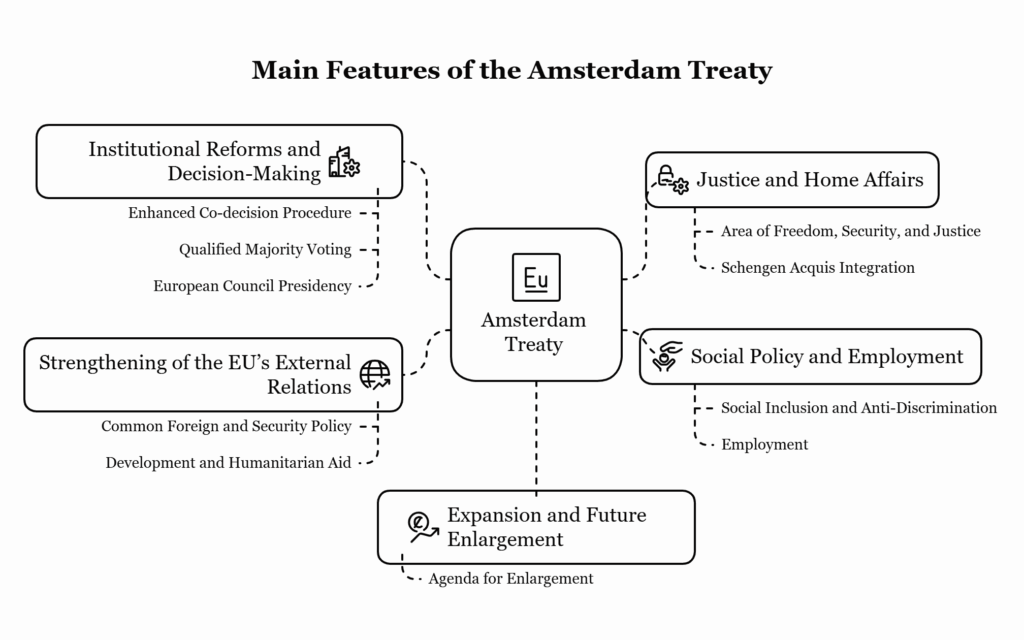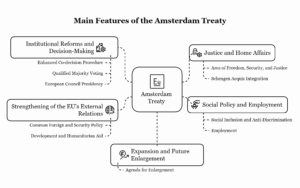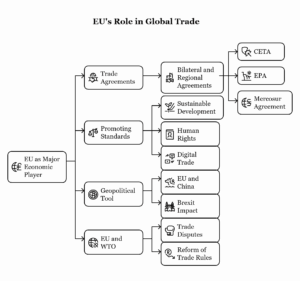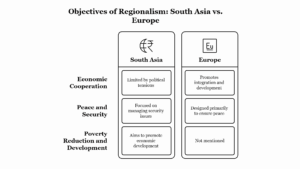The Amsterdam Treaty, signed on October 2, 1997, and entered into force on May 1, 1999, represents a significant milestone in the evolution of the European Union (EU). It revised the Treaty on European Union (TEU) and the Treaty establishing the European Community (TEC), with the goal of enhancing the EU’s functioning in response to the challenges posed by enlargement and the need for greater political and economic coordination. The treaty was a key step towards consolidating the integration process and laying the groundwork for future EU reforms, particularly in terms of decision-making, the area of justice and home affairs, and the enlargement of the Union.
Main Features of the Amsterdam Treaty
- Institutional Reforms and Decision-Making
One of the central goals of the Amsterdam Treaty was to reform the institutional structure of the EU to ensure it could function efficiently as the Union expanded to include new members in the future. The treaty focused on simplifying decision-making procedures and increasing the EU’s institutional capacity to respond to a growing number of member states.
- Enhanced Co-decision Procedure: The treaty strengthened the co-decision procedure, making the European Parliament a co-legislator with the Council of the EU in more policy areas, particularly in the areas of environment, employment, and public health. This expanded the role of the Parliament in the legislative process and ensured greater democratic legitimacy of EU policies.
- Qualified Majority Voting (QMV): The Amsterdam Treaty extended the use of Qualified Majority Voting (QMV) in the Council of the EU. This reform aimed to simplify decision-making by reducing the need for unanimity in more policy areas, thus preventing gridlock and ensuring more efficient policy adoption. However, the treaty also set a double majority rule—where decisions required the approval of 62% of the EU member states, representing 71% of the EU population.
- European Council Presidency: The treaty introduced a more regularized structure for the European Council by appointing a president for a two-and-a-half-year term, who was tasked with overseeing the work of the European Council and providing overall leadership in the political decision-making process.
- Justice and Home Affairs
The Amsterdam Treaty made substantial changes in the field of justice and home affairs, marking a shift towards a more integrated approach to issues such as immigration, asylum, and policing. Key developments included:
- Creation of the Area of Freedom, Security, and Justice (AFSJ): The treaty laid the foundation for creating an Area of Freedom, Security, and Justice, which aimed to harmonize policies on immigration, asylum, policing, and judicial cooperation across the EU. This was crucial for building a cohesive approach to managing borders, dealing with cross-border crime, and ensuring mutual recognition of legal judgments between member states.
- Schengen Acquis Integration: One of the key features of the Amsterdam Treaty was the incorporation of the Schengen Agreement into EU law. The Schengen Area, which had been established independently of the EU, allows for the free movement of people between participating states without internal border controls. Under the Amsterdam Treaty, all EU member states were required to gradually adopt the Schengen acquis, making it a part of the Union’s legal framework.
- Social Policy and Employment
The Amsterdam Treaty placed significant emphasis on the EU’s role in promoting social welfare, employment, and economic cohesion. It introduced provisions to strengthen the social dimension of the Union and enhance policies aimed at ensuring social inclusion and labor rights.
- Social Inclusion and Anti-Discrimination: The treaty expanded the EU’s commitment to social inclusion, establishing a legal basis for combating discrimination based on gender, race, disability, and age. The treaty promoted equal opportunities and better protection for workers’ rights within the Union.
- Employment: The Amsterdam Treaty also introduced the employment chapter, emphasizing the EU’s responsibility to improve employment levels and working conditions across member states. The EU was tasked with promoting policies that encourage job creation, tackle unemployment, and address regional disparities in labor markets.
- Expansion and Future Enlargement
A key consideration in the Amsterdam Treaty was the EU’s enlargement process, especially given the increasing number of countries in Central and Eastern Europe applying for EU membership. The treaty laid out the framework for future enlargements, emphasizing the need for deeper integration and the alignment of candidate countries with EU laws and standards.
- Agenda for Enlargement: The Amsterdam Treaty reinforced the EU’s commitment to enlargement by stating that the Union would continue to integrate countries from Central and Eastern Europe, as well as other candidate states, provided they met the necessary political and economic criteria. This would eventually lead to the enlargement of the EU in 2004, when ten new countries joined.
- Strengthening of the EU’s External Relations
The Amsterdam Treaty also made provisions for the EU’s external relations and its role in the global order, particularly in terms of foreign policy and security.
- Common Foreign and Security Policy (CFSP): The treaty sought to strengthen the Common Foreign and Security Policy (CFSP) by providing clearer guidelines for action and introducing more effective decision-making procedures. It established the role of the High Representative for CFSP, who was tasked with representing the EU in international diplomacy, as well as enhancing the coordination of member states’ foreign policies.
- Development and Humanitarian Aid: The treaty also recognized the EU’s role in the global promotion of development and humanitarian aid, giving it a more prominent role in addressing global challenges such as poverty, human rights, and environmental protection.

Conclusion
The Amsterdam Treaty was a significant turning point in the history of European integration, focusing on improving the efficiency and institutional structure of the EU in preparation for future enlargement. It reformed decision-making procedures, expanded the EU’s role in justice and home affairs, enhanced its social policies, and integrated the Schengen Area into EU law. By laying the groundwork for enlargement and a more cohesive internal market, the treaty helped prepare the EU for its most significant expansion in 2004. While it made significant strides in improving governance and policy coordination, it also set the stage for future reforms, including those seen in the Treaty of Nice (2001) and Treaty of Lisbon (2007).








Leave a Reply